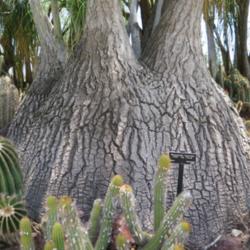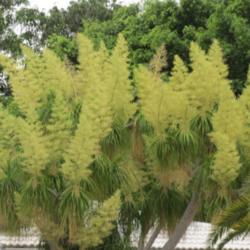The ponytail palm is one of the most common succulent trees in cultivation. Its interesting form and ease of care make it an excellent house plant or patio plant, given good drainage and lots of light.
This native of the tropical deciduous forests of eastern Mexico has a wide, enlarged base, recurved and reflexed leaves, and tiny unisexual flowers. It may reach several feet tall in a container, 15-50 feet tall in the ground, where the base may be 6 feet or more wide in old age. It is not any kind of palm, despite the English common name, being more closely related to yuccas and agaves. In Mexico it is called "pata de elefante" (elephant's foot), among other names.
The ponytail palm is propagated from seed (which requires separate male and female individuals in flower to produce) or rooted cuttings.
Plants started from cuttings will not tend to develop the same
extra-wide,
bottom-heavy proportions, and are generally less desirable. They are often beheaded at a relatively young age to take another cutting and start a new plant, thereby
forcing branching near the base. Here's
an example of the way the plant responds to the loss of its growth point. Otherwise branching is typically associated with
flowering, which occurs relatively late in life. Since flowers are terminal (the growth center turns into an inflorescence) the only way a stem can continue growing after flowering is to
branch at the base of the inflorescence, though perhaps not more than once.
Beaucarnea recurvata is usually a container plant in cultivation. It is very well behaved (though somewhat limited) in containers, and may
flower in them. Provide excellent drainage, strong light, and regular water when the soil is dry at depth (but not much sooner). Barring desert heat, it's impossible to provide too much sun.
This is by far the most common
Beaucarnea in cultivation (at least 10 times more common than the runner up). A couple of other species in the genus (
B. guatemalensis,
B. pliabilis) may be confused with it, but can be distinguished based on leaf differences. Another species with a wide, nearly globose base is
B. gracilis.
Variegated forms of B. recurvata exist, though they are uncommon, and they are typically propagated from rooted cuttings.
B. recurvata is grown in the ground in parts of California and Florida. The
Florida plants tend to look dramatically better during the summer because they (unlike the California plants) receive summer water in the form of rain. While this tree tolerates extreme drought, it does a lot better (and looks a lot nicer) when it gets regular water. Likewise, it tolerates extremely confined spaces but will grow considerably faster when allowed some space below ground.


